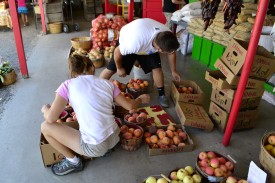Managing Editor
Photo by Leah Jane Davidson
When dinner alternates nightly between Easy-Mac and fast food, eating in college can become a pretty monotonous experience.
If you’re a CMU student craving something fresh and unique, it’s time to head 13 miles east to Palisade, the Grand Valley’s premier farm and wine country.
Palisade grows an extremely diverse range of products, including their famous peaches, cucumbers, apples, okra, tomatoes, onions, squash, purple bell peppers, and honey, straight from beehives right out the back door.
Mt. Garfield Fruits and Vegetables
Taking Patterson Rd. all the way through Clifton and over a bridge will bring you closer to ancient volcano and world’s largest flat-top mountain, the Grand Mesa. The first homegrown market in the foothills will be Mt. Garfield Fruits and Vegetables, and they will give you a full basket of the local fruit and veggie experience.
The first thing you see is peaches everywhere, in barrels and boxes. There is Thelma Hays instructing her employees on the presentation of their produce. Appearance really matters when you’re dealing with stuff picked in your backyard.
“We pick every day,” Hays said. “We can grow almost anything except kiwi and citrus. We even grow walnuts.”
A basket on a shelf displays full, brightly-colored onions, advertised as freshly picked, with large green stalks protruding from their tops. Sparsely placed around the shop, melons from elsewhere in Colorado sit in baskets.
“We grow 80 percent of what is sold here,” Hays said. Everything else comes from relatively close, and certainly not from outside the four-corners region. The shop evokes a down-home feeling, free from the almost clinical labeling and organization of the grocery store. Hays thinks this is what brings people back.
“Right from the farm to the hands,” she said.
Palisade’s produce is harvested in the late summer and early fall, filling shops like Hays’ to the brim with produce picked within the last few days. Hays mentioned relying on canning and other preservation methods during these months, ensuring a supply of local produce all winter long.
Red Barn Farmers Market
Moving on down the road, you’ll come across the Red Barn Farmers Market. While having a little less produce, they make up for it with quality. A large metal apparatus for roasting chilies is seen outside, not far from a sign to be put up when the fresh-roasted peppers are available.
Inside, you’ll find more of the Palisade staple, vegetables, along with locally canned, ready to eat peach, apple, and cherry cobblers, yearning for a piecrust and a scoop of ice cream.
What really makes the Red Barn stand out is a beehive encased in glass above a shelf packed with house-produced honey. A tube leads along support beams and through the wall outside, through which bees return with pollen to the hive.
Sprigs and Sprouts
Further down the road is Sprigs and Sprouts, a lavender farm with attached market that offers perhaps the most unique collection of product.
Just to the side of the parking lot is what looks like at least 100 lavender bushes. Rows of other produce carry on behind the field.
Upon entering, a room full of soaps, candles and tea showcases local craftsmanship with the local peaches, lavender and other herbs. In the back, long shelves with a selection of jams, sauces, beans and pickles from Colorado oppose a long row of coolers filled with local produce.
This place may have probably the most interesting mix of non-produce items, like lavender-infused pasta by Papardelle’s pasta, based out of Denver, and spice-infused Beehive Cheese from Uintah, Utah.
The farm also does aquaponics, a method of food-growing similar to hydroponics, but one that incorporates the use of small aquatic life in a symbiotic nutrient-sharing relationship with the produce. By using the system to grow in the off-season, Bailey hopes to have spinach, kale and other leafy greens available all winter long.
Sprigs and Sprouts also grows a unique kind of pea that comes in a purple shell. Linda Bailey, co-owner of Sprigs and Sprouts, says this particular kind of pea looks like the black-eyed pea, but is better in her opinion. She recommends boiling the peas with some fatty pieces of pork.
Where’s the meat?
“We have a few friends who raise pigs and such,” Bailey said. She suggests that as one gets more into the local network of food producers, they could make a few friends like she has and invest in those producers’ livestock, with the future promise of a freezer full of country-raised, natural meats. Until then, you can always find some eggs.
“You can go all up and down G Road and see houses with eggs for sale,” Kay Keenan, employee at Mt. Garfield Fruit and Vegetables, said.
After spending some time in Palisade, one realizes that these folks don’t have to go to the grocery store for much.
“I haven’t been to one in a while,” Keenan said.
Bailey spoke about the impact and benefits of eating local produce.
“The produce in the grocery store, you can eat it, but the vitamins are depleted,” she said. According to Bailey, food at the grocery spends at least a few days being packed and shipped, before spending at least a few more days in the store before you buy them.
“All you need is beans and rice for that matter,” Bailey said about how easy it is to make a nutritious meal from local staples.
Regardless of where, and possibly even when you head out to Palisade, there is likely to be an extremely fresh, nutritious product for you to eat.
“This valley is a cornucopia,” Hays said.
ealinko@mavs.coloradomesa.edu

Recent Comments